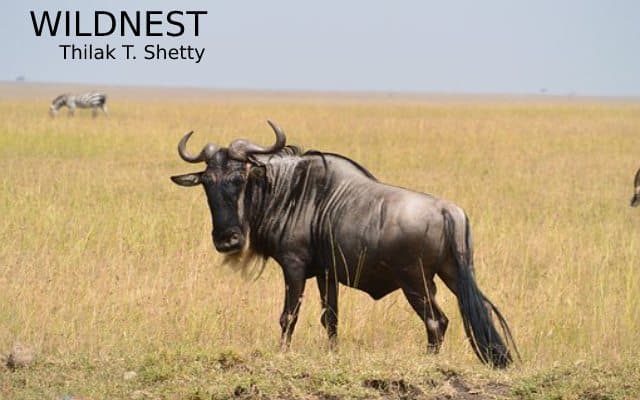Wildebeest, also known as gnu are antelopes of the genus Connochaetes and native to Eastern and Southern Africa. They belong to the family Bovidae.
There are two species of wildebeest. Species of wildebeest are even-toed, horned, greyish-brown ungulates resembling cattle. Males are larger than females and both have heavy forequarters compared to their hindquarters. They have broad muzzles, Roman noses, and shaggy manes and tails. In males, b wildebeest stand 150 cm (59 in) tall at the shoulder and weigh around 250 kg. In females, wildebeest have a shoulder height of 135 cm (53 in) and weigh 180 kg. The horns of one species of wildebeest protrude to the side, then curve downwards before curving up back towards the skull, while the horns of another species of wildebeest curve forward and then downward before curving upwards at the tips.
Wildebeest live in a wide variety of habitats, including woodlands and grasslands but some wildebeest tend to reside exclusively in open grassland areas. In some areas, the wildebeest migrates over long distances in the winter. The milk of the female wildebeest contains a higher protein, lower fat, and lower lactose content. Wildebeest can live more than 40 years, though their average lifespan is around 20 years.
Wildebeest inhabit the plains and open woodlands of parts of Africa south of the Sahara. The wildebeest is native to the southernmost parts of the continent. Its historical range included South Africa, Eswatini, and Lesotho, but in the latter two countries, it was hunted to extinction in the 19th century. It has now been reintroduced to them and also introduced to Namibia, where it has become well established. It inhabits open plains, grasslands, and Karoo shrublands in both steep mountainous regions and lower undulating hills. In the past, it inhabited the highveld temperate grasslands during the dry winter season and the arid Karoo region during the rains. However, as a result of widespread hunting, the wildebeest no longer occupies its historical range or makes migrations, and is now largely limited to game farms and protected reserves.
Wildebeest do not form permanent pair bonds and during the mating season, or rut, the males establish temporary territories and try to attract females into them. These small territories are about 3,000 square metres, with up to 300 territories per 1 square kilometre. The males defend these territories from other males while competing for females that are coming into oestrus. The males use grunts and distinctive behaviour to entice females into their territories. Wildebeests usually breed at the end of the rainy season when the animals are well-fed and at their peak fitness. This usually occurs between May and July, and birthing usually takes place between January and March, at the start of the wet season.
Wildebeest females breed seasonally and ovulate spontaneously. The oestrous cycle is about 23 days and the gestation period lasts 250 to 260 days. The calves weigh about 21 kg at birth and scramble to their feet within minutes, being able to move with the herd soon afterwards, a fact on which their survival relies. The main predator of the calves is the spotted hyena. The calving peak period lasts for 2 to 3 weeks, and in small subpopulations and isolated groups, the mortality of calves may be as high as 50 per cent. However, in larger aggregations, or small groups living near large herds, mortality rates may be under 20 per cent.
Groups of wildebeest females and young live in the small areas established by the male. When groups of wildebeest join, the female-to-male ratio is higher because the females choose to move to the areas held by a smaller number of males. This female-dominated sex ratio may be due to illegal hunting and human disturbance, with higher male mortality having been attributed to hunting.
• The wildebeest is depicted on the coat of arms of the Province of Natal and later KwaZulu-Natal in South Africa. Over the years, the South African authorities have issued several stamps displaying the animal and the South African Mint has struck a two-cent piece with a prancing black wildebeest.
• Movies and television shows also feature wildebeests, including Khumba, The Wild, All Hail King Julien, Phineas and Ferb, The Great Space Coaster, and The Lion King (the wildebeest stampede that resulted in Mufasa’s death).
• Michael Flanders wrote a humorous song called “The Gnu”, which was very popular when he performed it, with Donald Swann, in a revue called At the Drop of a Hat, which opened in London on 31 December 1956.
• In the 1970s, British tea brand Typhoo ran a series of television advertisements featuring an animated anthropomorphic gnu character.
• The wildebeest is the mascot of the GNU project and the GNU operating system.




